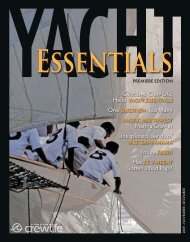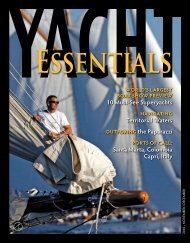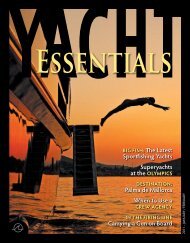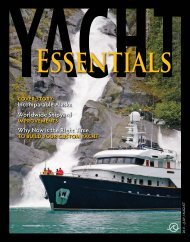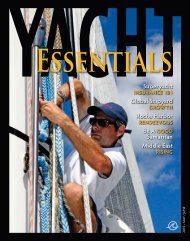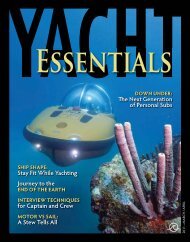photo contest - Yacht Essentials
photo contest - Yacht Essentials
photo contest - Yacht Essentials
You also want an ePaper? Increase the reach of your titles
YUMPU automatically turns print PDFs into web optimized ePapers that Google loves.
THE MCA IN MGN 315 (M) EXPANDS ON THIS<br />
WITH: “8.2 The look-out must be able to give full attention<br />
to the keeping of a proper look-out, and no<br />
other duties shall be undertaken that could interfere<br />
with that task. The duties of the look-out and helmsman<br />
are separate, and the helmsman should not be<br />
considered to be a look-out except in small vessels<br />
where an unobstructed all-around view is provided at<br />
the steering position and there is no impairment of<br />
night vision or other impediment to the keeping of a<br />
proper look-out.”<br />
The above two paragraphs are not open to interpretation.<br />
They are law. Unless you have a suitably qualified<br />
crew member on the bridge with radars operating “at<br />
all times,” then you are breaking the law and not only<br />
endangering the yacht, the crew and passengers under<br />
your command, but also all other vessels, personnel and<br />
the environment in your area.<br />
There was an incident in the anchorage off St. Tropez during<br />
the 2010 Mediterranean season where a large Feadship<br />
dragged anchor, colliding with another anchored<br />
motor yacht. This is an all too common incident, and it<br />
occurred because all crew were engaged with guests<br />
and owners (there was a party aboard) and no one was, it<br />
has been revealed, available for anchor watch.<br />
My argument remains that there is an endemic design<br />
fault in the majority of yachts that not only results in insufficient<br />
crew numbers to fully comply with obligations<br />
toward maritime law but also does not allow crew members<br />
to fully provide the resort-like services their guests/<br />
owners quite rightly demand.<br />
CASE IN POINT: There is a well-known Dutch shipyard<br />
that builds semi-custom yachts in the 47-metre range<br />
that is equipped with bunks for eight crew — nine if the<br />
captain is part of a couple. This model is built to and<br />
complies with the MCA LYII Code. How can the MCA or<br />
the Flag States think a captain can operate a yacht of this<br />
size with this number of crew and do so legally while also<br />
providing crew with the required hours of rest?<br />
The MCA, Flag States and Classification Societies have<br />
never considered the problem we have, nor have they<br />
fully investigated what numbers of crew are required<br />
to operate a yacht to acceptable standards in all areas<br />
and departments. A yacht has to be greater than 500GT<br />
before authorities decide to even issue a Safe Manning<br />
Document. This is as ludicrous as it is unprofessional.<br />
Most yachts, and hence their captains and crew, simply<br />
do not operate legally. Whilst some (and I stress “some”)<br />
yachts are operated legally and professionally, they are<br />
the minority, and typically over 3,000GRT and commanded<br />
by a Master Class 1.<br />
The MCA’s standard comment has been, “Captains and<br />
companies must ensure the rules and regulations are<br />
complied with,” which is an over simplification of a very<br />
difficult problem — and quite simply a cop out on their<br />
behalf. The time has come when this industry has a long,<br />
hard look at what we deem acceptable, and how endemic<br />
and continued illegal activity can be deemed acceptable<br />
as “a part of yachting.”<br />
The only way to ensure that yachts are designed and built<br />
to accommodate and carry sufficient crew to operate legally<br />
is through legislation, and this push must come from<br />
industry-representative bodies such as the Professional<br />
<strong>Yacht</strong>smen’s Association (PYA). The International Labor<br />
Convention’s Maritime Labor Convention 2006 is an excellent<br />
start. Sadly, the yachting industry and the PYA in<br />
particular have attempted to dilute this convention, leaving<br />
captains and crew with no alternative but to operate in<br />
violation of basic maritime law and regulation.<br />
I come from a commercial background, and the unprofessional<br />
thread of “acceptable behavior” I see throughout<br />
the yachting industry is horrifying. Whilst no one<br />
wants to see “the big one” happen to anyone, I cannot<br />
help but feel that a catastrophic accident involving a superyacht<br />
may not be too far away.<br />
Captain Sue Denim has more than two decades of experience<br />
in the marine industry and has been an instructor<br />
at a leading maritime institution. She has completed four<br />
new build projects up to 70 meters and has run superyachts<br />
all over the world.<br />
Unless you have a suitably qualified crew member on the bridge with radars<br />
operating “at all times,” then you are breaking the law.<br />
www.<strong>Yacht</strong><strong>Essentials</strong>.com 55




